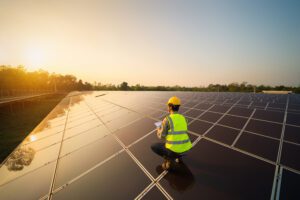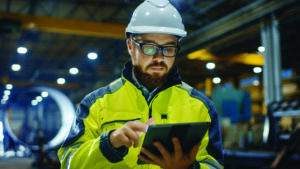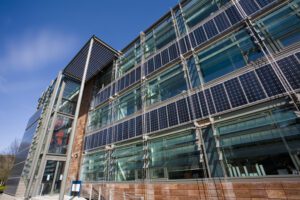On August 16, President Biden signed the Inflation Reduction Act of 2022 — a historic effort in the collective fight to curb climate change. I’m sure I wasn’t the only one who literally shouted “YAY!” out loud at my desk even though I was solo. This “breakthrough” law represents “the largest investment in combating climate change ever passed by Congress — driving down carbon pollution 40% below 2005 levels by 2030.”
We now have a golden opportunity to use a lot of federal funding to keep the United States competitive in the global economy and to accelerate decarbonization within the country. We can do both!
The law will inject $369 billion into the energy transition. What is the best way to seize this milestone moment? First, we need to think in generational timeframes while laying down the foundation today to bring about a clean future well past 2050. We cannot let this opportunity go to waste, especially given the legislation’s specific incentives across the entire energy value chain — from grid to plug, and from industrial scale microgrids to rooftop solar nanogrids in homes.

There are three practical steps to take now to truly move the needle on climate change, finally, for the long haul.
-
Think of digital models of infrastructure projects as just as important the tried-and-true construction itself
New infrastructure projects will be around for decades. Being able to ideate, design, and model project performance in the digital space before a shovel hits the ground will ensure such long-term projects are designed efficiently from the start and operate just as efficiently years down the road. This same digital approach is also true of retrofit and modernization projects.
How do you create a digital model? That’s where CAD (Computer-Aided Design) comes into play; specifically, CAD modeling tools called digital twins can create a simulation of a project — whether a new net-zero building, a microgrid, an EV fleet charging facility, or retrofits — that enables sophisticated analysis of different design decisions. That way, you know just how much energy and carbon you’re creating and consuming well before a shovel even hits the dirt.
We estimate digital twins can save 30% on construction time. Why? They essentially give you a single-source-of-truth software platform that connects design, procurement, communications, spreadsheets, and more. Mistakes are contained to realm of cyberspace.
This digital approach gives you peace of mind in knowing that any hefty capital investments are directed only at tested and refined projects that will deliver measurable energy savings. Thanks to digital ideation, your infrastructure project is better positioned to be on-time, on-budget, and seamlessly on-line at commissioning — and set up for better performance.
-
Look at the infrastructure of the future that’s already proven its value
The good news is that you don’t have to start from scratch when imagining infrastructure of the future. We know that the right infrastructure can and will support a sustainable economy; the wrong infrastructure will inhibit one. Let’s get it right.
Microgrids are a wonderful technology for fast-tracking your path toward net zero. In California, for instance, the Port of Long Beach and Schneider Electric™ have started construction on a $12.2 million microgrid project that will provide reliable, zero-emissions electricity for the port’s Joint Command and Control Center. With an expected production of 520 MWh annually, the project will reduce the port’s reliance on diesel backup generators and cut its electric costs by more than $60,000 a year. It’ll also help power surrounding neighborhoods when the grid is under stress.
We commend the Inflation Reduction Act for providing $3B in grants to reduce air pollution at ports. Let’s consider where to apply the Port of Long Beach model, also keeping in mind the people on the other side of the plug. What that means is approaching resilience at our ports as a strategic and economic imperative — done so in a way that benefits the broader community in terms of air quality and noise control.
-
Focus on the system level for maximum social and environmental impact
Any infrastructure project with digitally validated emissions reductions is a check mark in favor of a better future. Even better, though, are system-wide projects that connect the dots from grid to plug. At present, overall waste in the energy sector amounts to about 65%. If we simply build out clean energy capacity without solving for efficiency on the demand side, we’ll face a much larger uphill climb toward a net-zero economy. And if we simply deploy EVs and electrification on a massive scale without thinking through the impacts on the grid, we’ll face reliability issues.
Yet again, microgrids offer a systemic solution to these issues. We can look to the Brookville Smart Energy Bus Depot in Maryland as an example of how systems thinking drives deeper carbon- and cost-savings. This is a 6.2 MW microgrid, which is the equivalent of what over 1,000 homes consume. Adding 1,000+ homes-worth of capacity on the grid for a single bus-charging station would put a lot of stress on the system. But by integrating distributed energy resources (DERs) and using intelligent controllers that manage loads in real time, this climate-friendly project becomes sustainable and attainable.
That’s the kind of systems thinking and approach — and the technology system itself — we need to make measurable strides. This microgrid will support the county’s goal to reach net-zero emissions by 2035. Any locality that is in the process of purchasing EV buses using IRA funding should be considering the same approach as the Brookville project to ensure grid stability and security.

Resilience from project to people
I hope I’ve helped you clearly imagine what infrastructure could look like in 2050 if we do it right with the help of the Inflation Reduction Act of 2022. Let’s not even imagine what it’ll look like if we do it wrong.
Doing it right means designing with digital models. It means harnessing proven solutions available today, such as clean-energy microgrids and electrification. And it means looking at how people and planetary systems interact with this new infrastructure, beyond just kilowatts and kilograms of CO2. That’s building resilience from project to people — accelerating the energy transition for the greater good of all. Only then can everyone breathe a fresh, clean sigh of relief for the nation’s energy future.
We’re helping some of the world’s largest organizations, from PepsiCo to Walmart, on their decarbonization journeys. To discover the proven path any organization can take to decarbonize, check out our e-guide that walks through how to set targets, measure progress, and sustain results.



